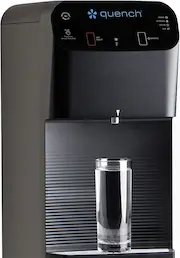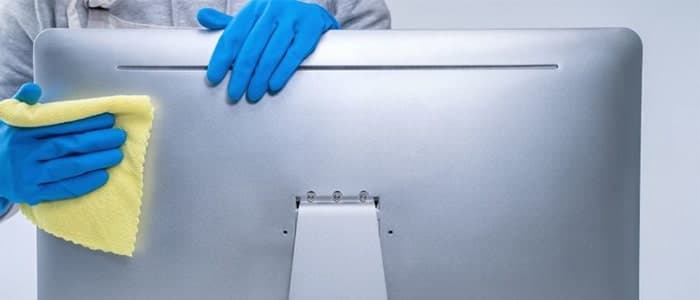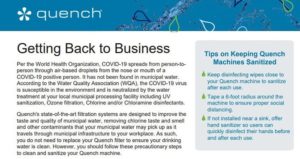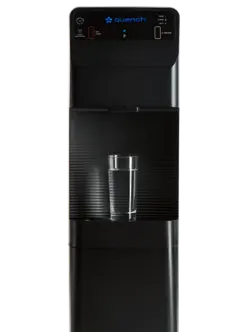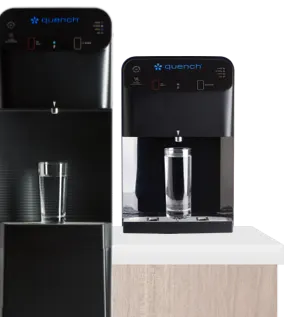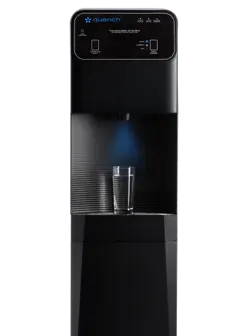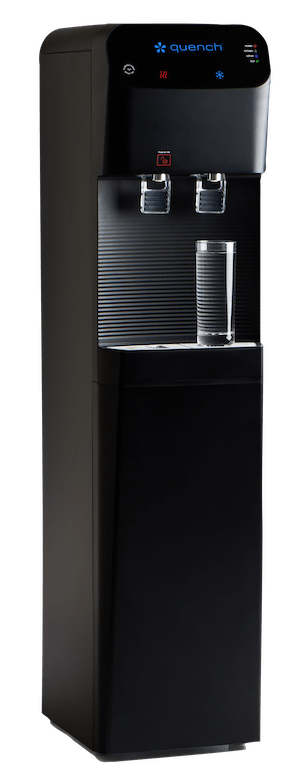Quench is the leading provider in clean drinking water solutions for businesses nationwide. Therefore, the health of our employees and the health of our customers’ employees, guests, and patients is our top priority. There are many benefits that can come from sending your employees back to the office, such as increased collaboration and productivity. [1] However, we also understand that there may be concerns around working in communal spaces and touching shared surfaces like office water coolers.
The Quench Water Experts put together the following office cleaning guide based on our expertise and the CDC’s Guidance for Cleaning and Disinfecting Public Spaces, Workplaces, Businesses, Schools, and Homes. Cleaning and disinfecting your workplace will require you to develop, implement, maintain, and continuously update your plan. Follow these tricks and tips we’ve listed below to establish effective sanitization procedures and keep you and your employees safe.
Clean High-Touch Surface Areas Regularly
Proper and regular cleaning and disinfection is key to bringing people back into your office workspace. Once your workers return to the office, pay close attention to high-touch surface areas like doorknobs and handles; buttons on copiers, printers, water coolers, and vending machines; and countertops in cafeterias, waiting rooms, and break rooms. Be sure to wipe each surface area down with EPA-approved disinfectants.
The EPA’s list of disinfectant products has shown to be effective against viruses that are harder to kill than viruses like the one that causes COVID-19. The list includes ready-to-use sprays, concentrates, and wipes. You can also consult this list of EPA-approved disinfectants to determine the most appropriate products for the specific objects you are cleaning.
Many disinfectants come with instructions. Read the labels – recognizing the contact time that the chemical needs to sit on the surface is a necessary consideration when cleaning and disinfecting.
Visit the CDC’s website on How to Clean and Disinfect for additional details and warnings.
Rearrange Your Waiting Room and Break Room
In the post-COVID-19 era, consider rearranging your waiting rooms and break rooms, spacing your furniture six feet apart. The CDC also recommends removing soft and porous materials, such area rugs. If you plan to add communal upholstery, favor fabric that breaths easily and does not trap heat. Most couches and chairs have tags on the cushions with cleaning instructions. Follow those instructions using the warmest appropriate water settings. You can find more best practices for cleaning furniture in your office here.
Provide Your Custodial Staff with Personal Protective Equipment (PPE)
Office cleaning personnel face an increased risk of being exposed to the virus and should be equipped with proper PPE such as face masks and gloves. The chemicals they use to clean the office can also pose a health risk as well. Your custodial staff should also have a firm understanding of how to use each individual cleaning product correctly to help limit the spread of germs and prevent acute toxicity.
Be Transparent About Your Building’s Cleaning Procedures
Before sending everyone back to the office, make sure your employees understand the new cleaning and sanitation procedures that you will put in place to protect them. A virtual announcement – either via email, video call, or phone call – is a great way to clearly explain how you plan to prioritize your workers’ health. Company-wide announcements are an opportunity to communicate new custodial procedures and remind your employees to practice social distancing, wear facial coverings, and follow proper preventative care like washing hands and using alcohol-based hand sanitizer.
Another way to ensure your employees that you’re taking care of them is to show them how often your building is cleaned. For example, you can have your custodians hang updated cleaning logs on the outside of the bathroom doors. Cleaning staff can mark the times and days they washed the facilities. That way, when your employees go to the restroom, they can quickly see the last time it was sanitized and feel more comfortable about using the communal space.
Post Hand Washing Posters in the Bathrooms and Kitchens
Hand washing might seem self-explanatory, but you’d be surprised how often people get it wrong. A thorough cleaning calls for at least a 20 second scrub, covering all surfaces, including between your fingers and under your fingernails.
The CDC offers colorful hand washing posters designed for all audiences to help raise awareness about handwashing in highly visible public areas. Some are even offered in multiple sizes and languages. Review an array of printable posters here.
Place Hand Sanitizer and Disinfectant Wipes Near all High-Touch Areas
Before you give your employees the green light to return to the workplace, make sure the proper hygiene products are in place. According to CDC guidelines for COVID-19, alcohol-based hand sanitizer (at least 60% alcohol) and/or EPA-approved disinfectant wipes are effective combatants against the disease. Normal routine cleaning of hands and surfaces lowers the risk of spreading COVID-19 infection. So, it’s wise to place hand sanitizer and/or cleaning wipes next to all frequently touched surfaces to give employees the convenient option to wipe down surfaces and disinfect their hands right away.
Add More Water Coolers to Reduce the Risk of Spreading COVID-19
Hydration is a big part of staying healthy and alert in the office. Thus, removing your employees’ office water source entirely could likely lead to other health risks and make it harder for their bodies to fight off infections.
A bottle delivery service may sound like the most logical solution to this problem. However, during a pandemic, it’s worth finding ways to reduce office visitors. A bottle delivery service requires delivery men and women to regularly travel in and out of multiple buildings a day and handle water bottles that your employees will eventually handle. In addition, bottles from a bottle delivery service are likely to be stored in highly trafficked office refrigerators that are touched by people all day. Instead, invest in a bottle-free water cooler to reduce the spread of germs.
A bottle-free cooler is not only safer than a delivery service, it’s significantly cheaper. A single bottle-free water cooler that serves 50 employees costs a company around $700 a year on average. A bottle delivery service that serves 50 people, on the other hand, cost a company over $4,200 a year on average. Therefore, adding five new bottle-free coolers to your workplace is still going to be less expensive than a bottle deliver service. If you designate single coolers to various departments across your company, the handling of those water dispensers will be minimal compared to other surfaces in the office like refrigerators.
You can control the risk of contraction even further with Quench’s touchless water coolers. Schedule a virtual consult with a Quench Water Expert to ask about our hands-free options like the Q7 foot pedal, our sensorSAFE 980/985 Series, and the Hydration Station.
At Quench, your health and the health of your employees, guests, and customers are our top priority. When you return to work, you can rest assured the Quench Water Experts will be there to supply you with the filtered, great-tasting water you’ll love. Learn more about Quench and our water services here.
[1] https://www.uschamber.com/co/start/strategy/benefits-of-coworking-spaces
